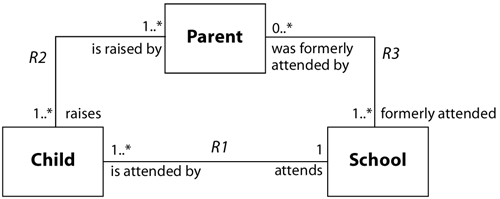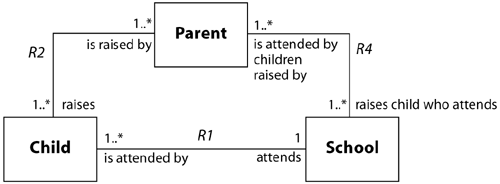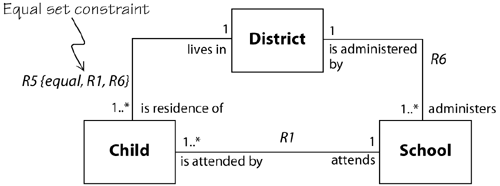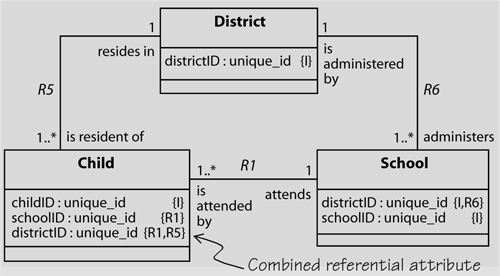8.4 Association Loops
| When we build a model with many classes and associations, it is often possible to trace a path from a class, through other associations and classes, back to the class whence we came. This pattern in the graphic is referred to as an association loop. Definition: An association loop is a set of associations that together make up a path from one class, through other classes, back to the same class. An association loop sometimes has a meaning separate from the sum of its parts, and sometimes it doesn't. Proper analysis of loops enhances our understanding of the problem and the diverse constraints between the associations in the domain. In this section, we will examine several types of association loops:
8.4.1 Unconstrained Association LoopsAn unconstrained association loop is one in which a path from one class to another in the same loop moving in one direction can lead to completely different sets of instances than going in the other direction. Consider Figure 8.15, for example. Figure 8.15. Loop of Unconstrained Associations
Starting from the Parent class, a given parent formerly attended some number of schools. Moving in the other direction from the Parent class, a Parent raises some number of (school-age) children, each of whom attends school. While it is possible that some students attend the same school their parents formerly attended, it is certainly not a requirement. Any matching associations between the set of schools attended by a parent and the set of schools attended by children of those parents is purely coincidental. The association loop is unconstrained in that examining the set of instances reached by traversing in one direction around the loop does not impose constraints on the set of instances reached by traversing in the other direction. There are no additional constraints not already described by existing associations, making our job easy. The model in Figure 8.15 is fine as is. 8.4.2 Redundant AssociationsIf we attempt to model every possible association between classes, some associations may be redundant. Consider Figure 8.16. Figure 8.16. Redundant Association in a Loop
The RAISES CHILD WHO ATTENDS association is nothing more than the concatenation of the two other associations and captures no new information. The name of the association even reads like a concatenation of two other associations, and the presence of the Child class in the name of the association is an obvious clue to its redundancy. The association is completely redundant and should not be added to the model. In such cases, the redundant association, R4, should be removed. 8.4.3 Equal Set ConstraintsIn other situations, domain rules and policies are such that the two sets of associations yield identical sets of instances but mean different things. Figure 8.17 illustrates the case where it is policy that a child can attend a given school only if the child lives in the same district as that school. Figure 8.17. Loop of Constrained Associations
Figure 8.18 shows how the association description incorporates the real business rule "child can only attend a school in the district where he lives" on the Child class. The constraint can be expressed in OCL, as shown in Figure 8.19. Figure 8.18. Description of a Constrained Association
Figure 8.19. OCL for the Equal Set Constraint
The constraint can also be written as a boolean function in action language. An example for any instance of Child is shown in Figure 8.20. Figure 8.20. Action Language for the Equal Set Constraint
When the set of instances selected by traversing a loop in one direction has to be the same as the set of instances selected by traversing the loop in the opposite direction, we say that the loop is subject to an equal set constraint. In Figure 8.17, the instances selected by traversing from Child to District directly (R5) has to be the same as the set of instances selected by traversing via the Child class (R1 + R6), according to the rules and policies of the domain. This commonly occurring constraint can be written on the class diagram as shown in Figure 8.21. Figure 8.21. Graphical Representation of an Equal Set Constraint
8.4.4 Subset ConstraintsConsider the following: A parent may be a member of the Parent Teacher Association (PTA) only of a school attended by the parent's child. For example, a parent with one child attending school A and another child attending school B could serve on the PTAs of A, B, both, or neither, but that parent cannot serve (as a parent) on the PTA of just any school. This association loop is constrained so that the set of instances selected by traversing from parent to school directly (R7) has to be a subset of the instances selected by traversing via the Child class (R2 + R1), according to the rules and policies of the domain, as shown in Figure 8.22. Figure 8.22. Subset Constrained Associations
The association is described in Figure 8.23. Figure 8.23. Description of a Subset Constrained Association
The OCL is:
and the action language is:
Contrast this with the OCL for the equal set constraint. In Figure 8.19, the predicate stated that two sets must be equal; however, in the example above, the derived association is a subset. One or both parents may serve, but only if one of their children attends that school. The subset constraint is depicted in Figure 8.24. Figure 8.24. Graphical Representation of a Subset Constraint
|
EAN: 2147483647
Pages: 161











